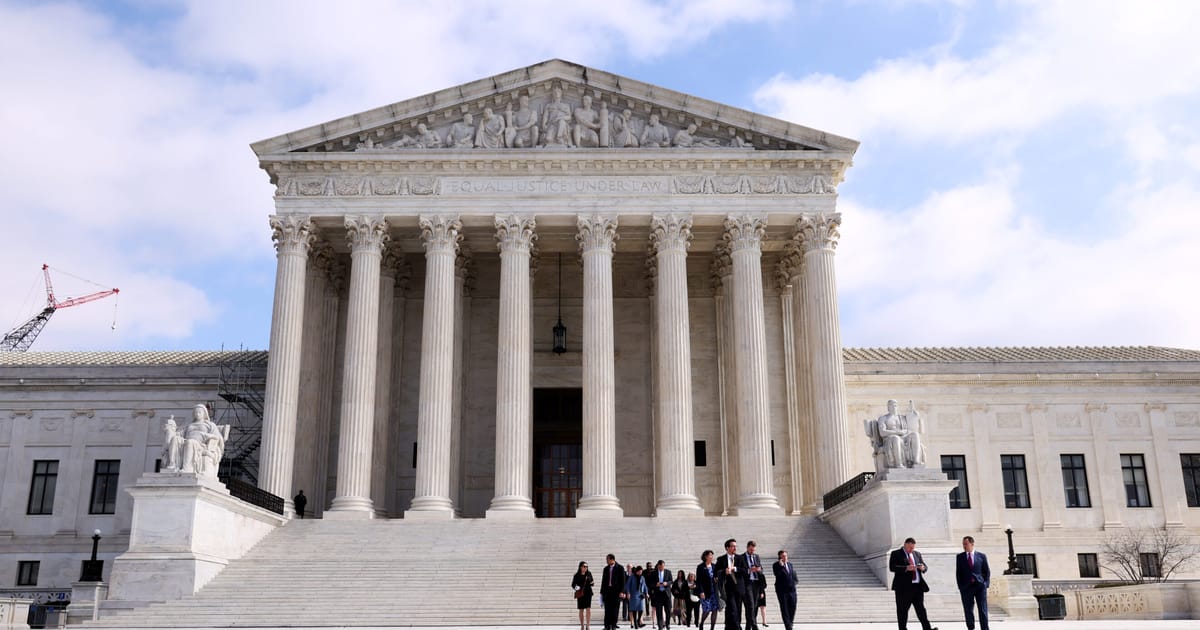Access to a widely used abortion pill will remain at current levels for the time being, the U.S. Supreme Court ruled Friday in a decision staving off sweeping restrictions ordered by lower courts.
The high court’s decision keeps the drug, mifepristone, available for now, but the legal battle over the drug, which has become the most common method of abortion nationwide, could drag on for months if not years to come.
Justices Samuel Alito and Clarence Thomas dissented from the Supreme Court’s action, which prevents earlier rulings from a Texas-based judge and a federal appeals court from taking effect.
Those rulings would have suspended several policies the FDA enacted since 2016 to make mifepristone more accessible — including telemedicine prescription, mail delivery, retail pharmacy dispensing and the approval of a generic version of the drug. The lower-court action also would have scaled back the federally approved use of the drug from 10 weeks of pregnancy to seven weeks — before many patients know they are pregnant.
The Supreme Court’s unsigned order on Friday keeps those rulings blocked while litigation continues — first at the 5th Circuit Court of Appeals and then, perhaps, back at the Supreme Court. As a result, the status quo for access to mifepristone will likely remain in place through the fall and perhaps well into next year.
The case could return to the justices for full briefing, oral arguments and a final decision in the summer of 2024, just as the presidential campaign gets into full swing.
President Joe Biden cheered the brief Friday ruling for “preventing a lower court decision from going into effect that would have undermined FDA’s medical judgment and put women’s health at risk.”
“As a result of the Supreme Court’s stay, mifepristone remains available and approved for safe and effective use while we continue this fight in the courts,” he said.
As is often the case when acting on requests for emergency relief, the court’s majority did not explain its reasons for granting the stay.
Thomas also offered no explanation for opposing the stay, but Alito wrote a four-page opinion detailing his reasons for rejecting it, often echoing arguments made by the anti-abortion challengers in the case.
Alito wrote the majority opinion last June in Dobbs v. Jackson Women’s Health Organization, which ended the federal constitutional right to abortion. But no other justice signed onto his dissent on Friday.
He argued that his colleagues should have allowed an April 12 preliminary ruling from the 5th Circuit to be implemented because the Biden administration and Danco Laboratories, the drug company that makes the brand-name version of mifepristone, didn’t show that they would “suffer irreparable harm” under that ruling.
The restrictions on the drug ordered by the appeals court, Alito wrote, “would not remove mifepristone from the market” but “would simply restore the circumstances that existed (and that the Government defended) from 2000 to 2016 under three Presidential administrations.”
Alito also speculated that, if the high court had allowed the 5th Circuit’s ruling to take effect, the Biden administration might have used “enforcement discretion” to avoid implementing the restrictions.
Danco and another drug company — GenBioPro, which makes the generic version of the drug — had told the Supreme Court that the restrictions ordered by the 5th Circuit could amount to a nationwide ban of the drug, at least temporarily. GenBioPro would lose its federal approval for the generic version, and Danco would have to revise its product labels, recertify providers, apply to the FDA for a new regulatory framework and jump through other time-consuming administrative hoops, potentially cutting off access to the pill for months.
Attorneys for anti-abortion groups dismissed these claims, urging the high court to “restore a modicum of safety for the women and girls who use the drug” by reimposing the FDA’s pre-2016 restrictions.
The fight over mifepristone now returns to the conservative-leaning 5th Circuit, which will review briefs from both sides beginning next week and is set to hear oral arguments on May 17.
Mifepristone has been used for decades as part of a two-drug medication regimen to induce an abortion early in pregnancy. These medication abortions have become increasingly popular, particularly as patients have availed themselves of the newer options for access, including drugs prescribed via telemedicine and sent through the mail. In the wake of the Dobbs decision, which allowed states to ban abortion within their borders, the pills have also become a key way patients have circumvented those laws.
Last year, anti-abortion medical groups sued to revoke the FDA’s original 2000 approval of mifepristone as well as the agency’s policies expanding access to the drug over the past seven years. A federal district judge appointed by former president Donald Trump, Matthew Kacsmaryk, issued a preliminary ruling earlier this month largely siding with the challengers. The 5th Circuit Court of Appeals narrowed Kacmsaryk’s ruling, keeping the drug on the market but suspending the policies that broadened access.
Numerous studies have found mifepristone to be safe and effective — whether dispensed in-person by a doctor or sent by mail. The country’s leading medical groups, including the American Medical Association, have petitioned courts to uphold FDA approval of the pill, vouching for the agency’s rigor and warning that siding with the challengers would open the door to a wave of cases going after everything from vaccines to birth control. The pharmaceutical industry has also cautioned that companies will hesitate to seek approval for new cures if they fear FDA approval could someday be second-guessed and overturned by courts.
While the Supreme Court’s decision maintains access to mifepristone at the federal level for now, Democratic state officials and medical groups are bracing for the possibility that judges could implement restrictions in the months ahead. Legislatures in some red states are also moving to enact state restrictions on the drug, on top of existing laws restricting abortions more generally.
Several blue states have recently moved to stockpile doses of either mifepristone or misoprostol — the second pill commonly used with mifepristone for medication abortions. Misoprostol can also terminate a pregnancy on its own, but it carries a slightly higher rate of complication and more side effects than the two drugs together.
Clinics as well as online vendors are preparing their doctors and nurses to pivot to offering misoprostol-only abortions if necessary. The drug, which is also used to treat stomach ulcers, is subject to fewer FDA restrictions than mifepristone.
The Supreme Court’s order came one week after the case reached the justices on an emergency basis. Alito, who handles emergency requests emerging from the 5th Circuit, acted twice to place temporary holds on the 5th Circuit’s ruling so that the justices could have more time to consider the matter.




